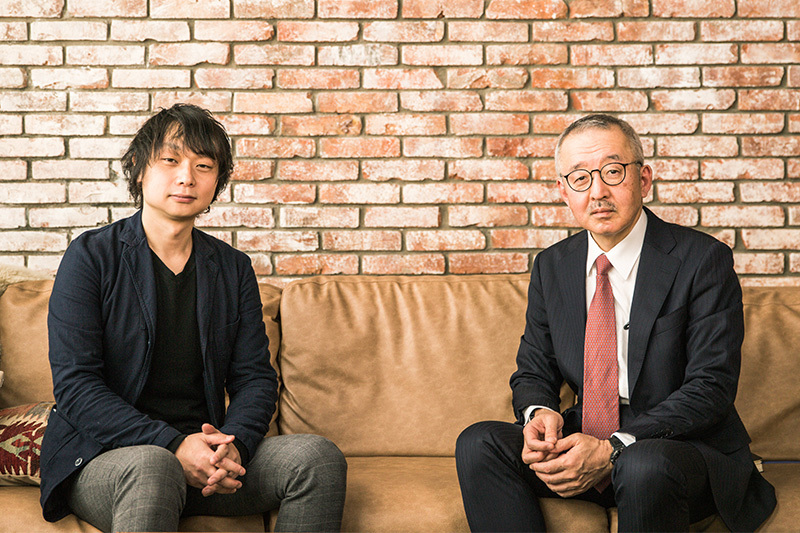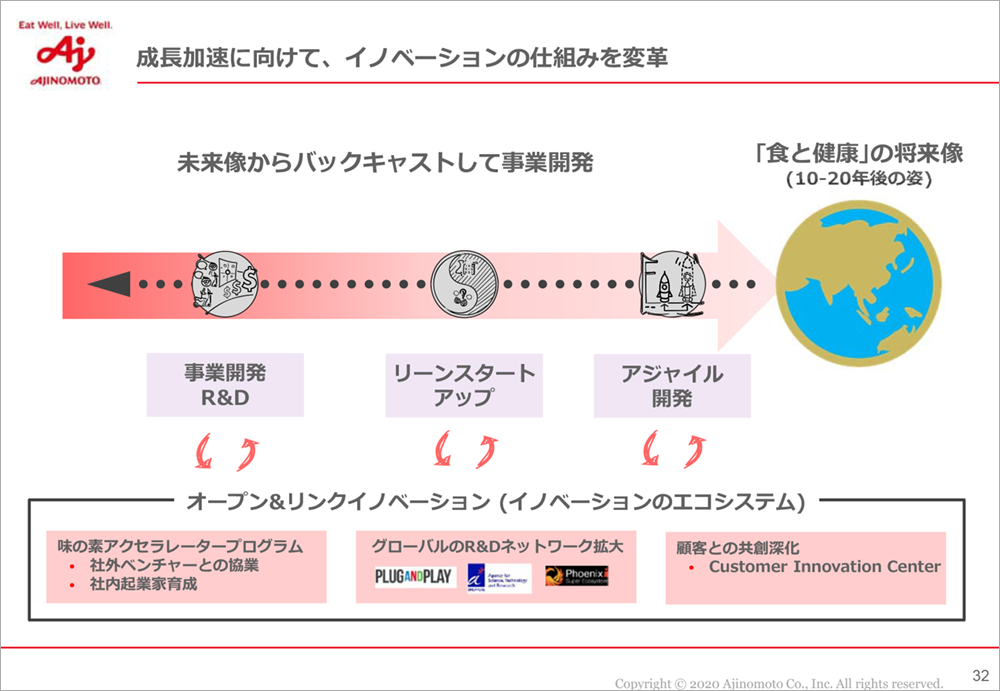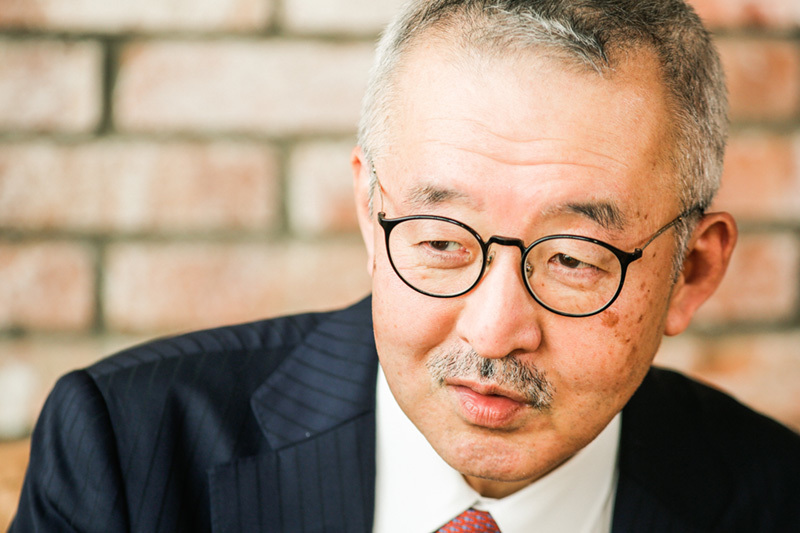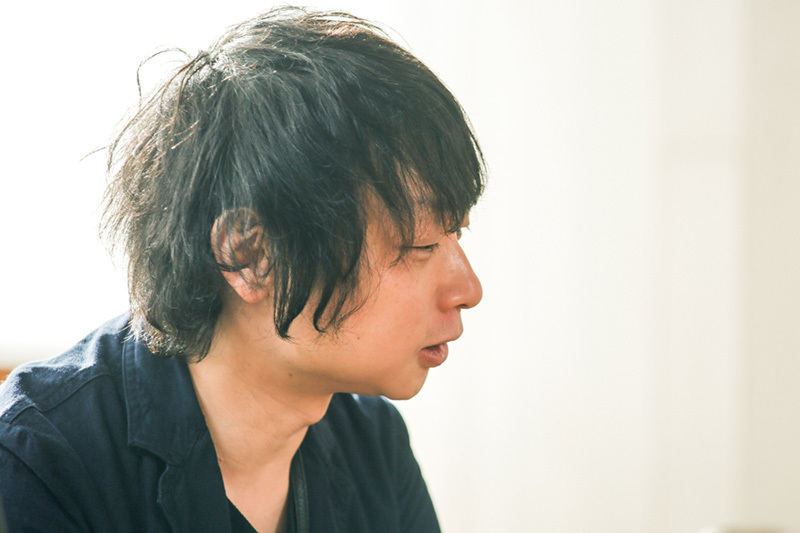"New value isn't emerging from within our own company."
"Our past strengths no longer hold value and have even become a burden."
"How can we turn small reform movements into a large wave of change within the company?"
We hear these concerns from many executives.
Amidst this, some companies are charting a comprehensive transformation architecture, challenging conventional wisdom through cross-functional initiatives. This series interviews top executives who personally act as architects driving business transformation within their organizations, delving into the essence of their approach.
For the first installment, we invited Hiroyuki Kojima, Senior Managing Executive Officer and CIO (Chief Innovation Officer) of Ajinomoto Co., Inc. (hereinafter Ajinomoto), for a dialogue with Shingo Yamahara of Dentsu Business Design Square (hereinafter BDS). We heard about the company's transformation efforts, the hurdles faced, and the future vision they are pursuing.

Ajinomoto CIO Hiroyuki Kojima (right) and Dentsu Inc. Business Design Square Shingo Yamahara
Envisioning the Future and Transforming the Ajinomoto Group's Business Model
Yamahara: Ajinomoto is currently advancing transformation toward its goal of "solving food and health challenges" by establishing a group-wide "Business Model Transformation Task Force." Please tell us about the core "Future Creation Project."
Kojima: I became General Manager of the R&D Planning Department in 2019 and have been thinking about the Ajinomoto Group's "next decade" ever since.
Typically, business plans are built based on what customers and society demand. However, when discussing the medium to long term, the "customer perspective" naturally becomes harder to see. This often leads to the opposite tendency: planning business strategies starting from our current technologies, thinking, "With our technology, we can do this."
But that approach cannot deliver sustainable growth. The Future Creation Project starts with the societal challenges and consumer needs of 2030. We consider what value the Ajinomoto Group should create to address them, then backcast to define the necessary business themes and processes.

Source: "Ajinomoto Group's ASV Management: Vision for 2030 and 2020–2025 Mid-Term Management Plan"
This concept gradually expanded, incorporating open innovation and corporate venture capital (CVC) operations. It is now being advanced as a company-wide initiative through the "Business Model Transformation Task Force."
Yamahara: Ajinomoto possesses numerous global intellectual assets, starting with the amino acid field. It's fascinating that Mr. Kojima, who led the research division, arrived at the conclusion that business cannot be built by thinking from assets, but rather from value.
Kojima: That perspective stems from my own experience. Since joining the company in 1985, I was involved in technology development at the research institute until transferring to my current department in 2019. During that time, I undertook numerous research projects focused on the medium-to-long-term future. While many successful technology developments led to patents, I also frequently felt that they didn't reach commercialization or translate into value for customers.
In truth, this was because we were conducting research based on what we could do at the time, failing to create value for future customers. I realize this now, but I wasn't aware of it back then.
These experiences led to a shift in thinking: "We must thoroughly understand the value for our customers and consider what we can do to achieve it."

From R&D to R&B. Moving beyond research and development to become a team that actively pursues commercialization.
Yamahara: The Research and Development Planning Department, led by Mr. Kojima, is spearheading the "Future Creation Project." In July 2020, you changed the department's name to R&B Planning Department (R&B: Research & Business), right?
Kojima: When you hear "Research & Development," doesn't it imply that the work ends with R&D? That someone else will handle what comes next?
Research & Business embodies the commitment to take responsibility from research through to providing value to customers and receiving payment.
The R&D Planning Department has traditionally been a cost center. Starting next fiscal year, we're advancing accounting procedures to enable it to function as a profit center generating revenue. This means selling the products developed through R&D, receiving payment from customers, and using that revenue as our budget.
Yamahara: That's a major shift from how we've worked and thought up until now.
Kojima: That's right. Selling naturally brings responsibility, requiring actions we haven't needed before, like ensuring quality and safety.
Yamahara: How have the employees reacted?
Kojima: Removing the barrier of "our role ends here" has actually made everyone more proactive.
Initiatives like this profit center transformation and the Future Creation Project are unprecedented for our company. Through this project, I feel that all employees, myself included, are now actively consulting with each other and sharing a common vision of where we should be heading.
Yamahara: With transformation and DX, there's a risk that the means become the end, and the question of what we should become in the process gets lost. But it sounds like everyone at Ajinomoto has internalized the need to change and is thinking about what needs to be done to achieve that.
Kojima: Talking with the project members, I realized how crucial the process of creating the "Picture of the Future" – the vision beyond the transformation – truly is.
Many companies may use terms like vision or purpose to describe their future image, but I believe the most important thing is to present a blueprint showing "what we can offer our customers" and "how we will create that value."

The desire to "make dreams come true" creates new value
Yamahara: The "Business Model Transformation Task Force" is also working on initiatives like the "Internal Entrepreneur Discovery Program." This project solicits ideas for new ventures from within the company and helps bring them to life. What were your impressions when you saw the submissions?

Source: "Ajinomoto Group Integrated Report 2020"
Kojima: What particularly impressed me was, first, the sheer number of employees who voluntarily raised their hands and applied. Moreover, many hadn't just thought about it after seeing this call for submissions; they were people who had been constantly pondering questions like "What is new customer value?" and "What can we achieve by leveraging the potential of the Ajinomoto Group?" That made me incredibly happy.
Looking back on myself, when I first joined the company, I certainly had aspirations of "wanting to do this kind of work." However, in reality, I ended up involved in many tasks that weren't aligned with what I truly wanted to do. While I always thought, "Someday, somewhere, I want to realize my vision," I also think there were times I became complacent with the status quo.
Also, while not numerous, some individuals have left the Ajinomoto Group to pursue careers at other companies or in different fields. Frankly, I hadn't fully understood why those people left the company. But hearing the stories of those who applied to this program, I completely understood: they left to realize their own aspirations somewhere else, aspirations they couldn't fulfill within the Ajinomoto Group.
That's precisely why I want to ensure that the employees who will carry the Ajinomoto Group forward don't leave the company. Instead, we must create opportunities within the company for them to realize their aspirations. I feel a renewed sense of responsibility to turn the ideas that emerge into business ventures and ultimately into value for our customers.
Yamahara: Even if someone had an idea before joining the company, without initiatives like this, they might have been swallowed up by daily work, their passion fading away. Ultimately, some might have left the company.
I believe that continuously creating mechanisms for people to meet and realize their dreams is itself driving the transformation of the Ajinomoto Group right now. It reaffirms my belief that new value develops from human connections and aspirations.

*Continued in Part 2











